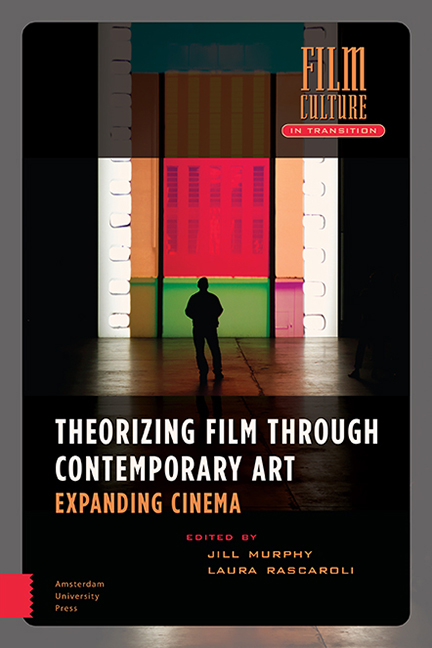Book contents
- Frontmater
- Dedication
- Contents
- List of Illustrations
- Acknowledgments
- Foreword: Courtesy of the Artists
- Introduction: On Cinema Expanding
- Part One Materialities
- 1 Cinema as (In)Visible Object; Looking, Making, and Remaking
- 2 Objects in Time; Artefacts in Artists’ Moving Image
- 3 Materializing the Body of the Actor; Labour, Memory, and Storage
- 4 How to Spell ‘Film’; Gibson + Recoder’s Alphabet of Projection
- Part Two Immaterialities
- 5 The Magic of Shadows; Distancing and Exposure in William Kentridge’s More Sweetly Play the Dance
- 6 Douglas Gordon and the Gallery of the Mind
- 7 A Throw of the Dice Will Never Abolish Chance; Tacita Dean’s Section Cinema (Homage to Marcel Broodthaers)
- Part Three Temporalities
- 8 The Photo-Filmic Diorama
- 9 The Cinematic Dispositif and Its Ghost; Sugimoto’s Theaters
- 10 Time/Frame: On Cinematic Duration
- Part Four The Futures of the Image
- 11 Interactivity without Control; David OReilly’s Everything (2017) and the Representation of Totality
- 12 Post-Cinematic Unframing
- 13 Absolute Immanence
- Index
3 - Materializing the Body of the Actor; Labour, Memory, and Storage
Published online by Cambridge University Press: 23 June 2021
- Frontmater
- Dedication
- Contents
- List of Illustrations
- Acknowledgments
- Foreword: Courtesy of the Artists
- Introduction: On Cinema Expanding
- Part One Materialities
- 1 Cinema as (In)Visible Object; Looking, Making, and Remaking
- 2 Objects in Time; Artefacts in Artists’ Moving Image
- 3 Materializing the Body of the Actor; Labour, Memory, and Storage
- 4 How to Spell ‘Film’; Gibson + Recoder’s Alphabet of Projection
- Part Two Immaterialities
- 5 The Magic of Shadows; Distancing and Exposure in William Kentridge’s More Sweetly Play the Dance
- 6 Douglas Gordon and the Gallery of the Mind
- 7 A Throw of the Dice Will Never Abolish Chance; Tacita Dean’s Section Cinema (Homage to Marcel Broodthaers)
- Part Three Temporalities
- 8 The Photo-Filmic Diorama
- 9 The Cinematic Dispositif and Its Ghost; Sugimoto’s Theaters
- 10 Time/Frame: On Cinematic Duration
- Part Four The Futures of the Image
- 11 Interactivity without Control; David OReilly’s Everything (2017) and the Representation of Totality
- 12 Post-Cinematic Unframing
- 13 Absolute Immanence
- Index
Summary
Abstract
Actors, extras, and models, engaged in scripted or staged performances, have featured prominently in artists’ film and video since the 1990s. But some artists have also used more specifically sculptural means to materialise acting bodies within the physical space of the gallery. Focusing on works by Cécile B. Evans, Nathaniel Mellors, and Clemens von Wedemeyer, this chapter explores how artists have articulated changes in the imagination of the human body, within the realm of acting and the performance of emotional labour. Their works suggest an emerging tension between the body conceived as an organic store of experience, following the logic of Method acting, and the body conceived as a surface for the display of signals, to be scanned and recognised by non-human things.
Keywords: Method acting; emotional labour; data storage; materiality; memory technologies; non-human bodies
Introduction: Bad Copies of Actor's Bodies
I’m just a bad copy […]. My voice is wrong and it's not even connected to my face.’ This confession emanates from ‘PHIL’ a computer-animated character in Cécile B. Evans's video Hyperlinks or It Didn't Happen (2014), which revolves around questions of authenticity. PHIL bears a very strong resemblance to Philip Seymour Hoffman, a celebrated exponent of Method acting techniques, who died before completing his contribution to the Hunger Games film series, prompting rumours of possible CGI use. PHIL is evidently anxious about his own digital status in common with other non-human entities (spambots, CGI objects, robots) that exhibit ostensibly human attributes in numerous works by Evans. However, I am specifically interested in the figure of the actor in her practice, and in specific works by two other artists – Clemens von Wedemeyer and Nathaniel Mellors – that share a concern with the corporeality and materiality of acting bodies. These works articulate changes in the imagination of the human body as source and store of emotion, both within the realm of acting and the wider context of performance. In particular, they articulate a dissonance between the body conceived as an organic storehouse of experience (following the logic of ‘sense memory’ within Method acting) and the body conceived as exterior, which functions as a surface (even a screen) for the display of signals that can be recognized and mediated by non-human things.
- Type
- Chapter
- Information
- Theorizing Film Through Contemporary ArtExpanding Cinema, pp. 83 - 100Publisher: Amsterdam University PressPrint publication year: 2020



